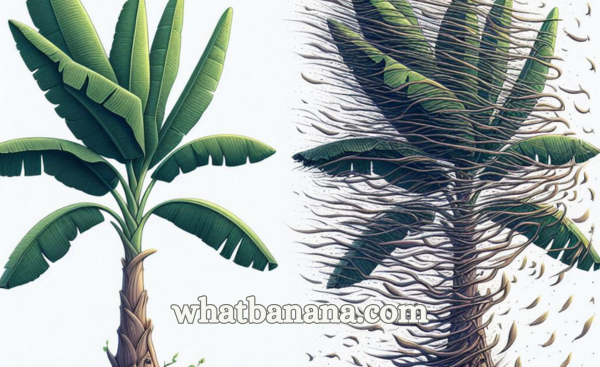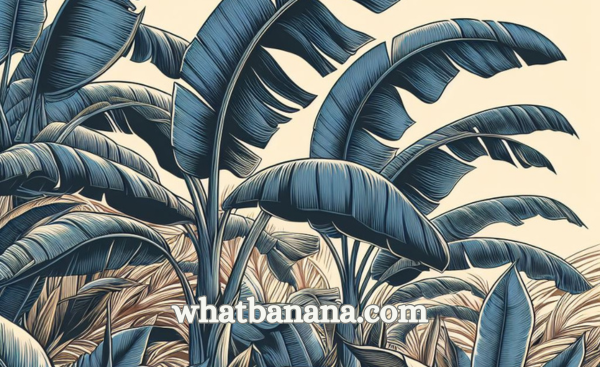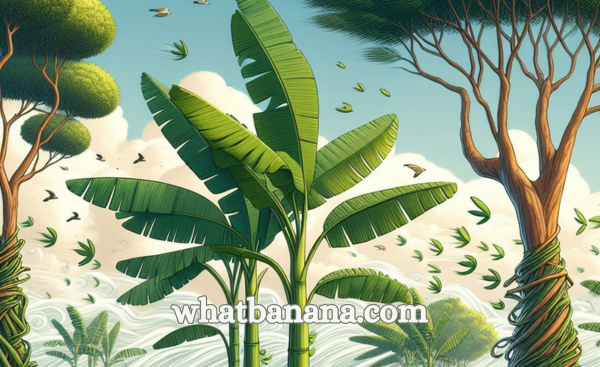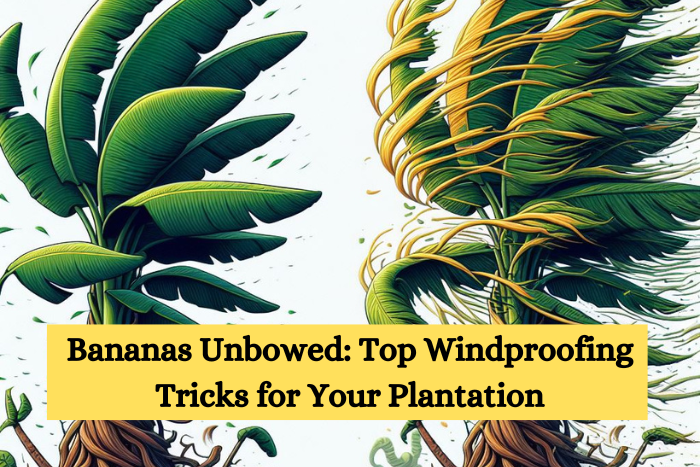Banana plants, with their large, broad leaves and relatively weak stems, are particularly vulnerable to wind damage.
In many regions where bananas are a key agricultural product, wind can pose a significant threat to plant health and crop yield.
Understanding the importance of effective wind protection strategies is crucial for anyone involved in banana cultivation.
Wind can have a variety of negative impacts on banana plants.
It can cause physical damage, such as leaf tearing and stem breakage, which not only affects the plant’s aesthetic but more critically, its ability to photosynthesize and support fruit development.
Beyond immediate physical damage, wind stress can lead to long-term detriments in plant growth, reducing overall yield and fruit quality.
For commercial growers, this can translate into significant economic losses, while for small-scale farmers, it can impact livelihoods and food security.
Banana Guard: Essential Strategies to Beat the Breeze
To mitigate these risks, a range of wind protection measures can be implemented.
These include the establishment of windbreaks, both natural and artificial, and the adoption of specific cultural practices that enhance the plant’s resistance to wind.
Furthermore, technological advancements and innovative approaches are continually emerging, offering new ways to protect banana plants from the damaging effects of wind.
This article aims to explore these various strategies in depth, providing insights into how each method can be effectively employed to safeguard banana plantations.
From traditional techniques to modern innovations, the focus will be on practical, sustainable solutions that can be adapted to different environments and scales of production.
By the end of this piece, readers will have a comprehensive understanding of the critical role wind protection plays in the successful cultivation of banana plants and the diverse methods available to achieve it.

Understanding the Impact of Wind on Banana Plants
The impact of wind on banana plants, often understated, is a critical factor that can significantly influence their health and productivity.
These plants, characterized by their large, expansive leaves and relatively soft stems, are particularly susceptible to wind damage.
Understanding the extent and nature of this impact is essential for implementing effective protection strategies.
One of the most immediate and visible effects of wind on banana plants is physical damage.
This includes tearing of the leaves, a common occurrence due to their size and surface area.
These tears not only reduce the aesthetic value of the plant but more importantly, impair the leaf’s ability to photosynthesize efficiently.
Photosynthesis is vital for the plant’s growth and fruit production; thus, damage to the leaves can have a direct impact on yield.
Wind stress goes beyond mere physical damage to leaves and stems.
It can cause a phenomenon known as ‘wind throw,’ where plants are uprooted or bent over due to strong winds.
This not only disrupts the plant’s growth but can also lead to the loss of the entire crop if the plants are unable to recover.
Additionally, wind can exacerbate water loss through evapotranspiration, leading to increased water stress for the plants, especially in arid conditions.
Long-term exposure to wind can have cumulative effects on banana plants.
Continuous wind stress can lead to stunted growth, as the plant expends more energy in reinforcing its structure rather than in growing and producing fruit.
The plant may also develop a thicker trunk and smaller leaves as adaptive mechanisms to withstand wind, further impacting its overall productivity.
In summary, wind poses a multifaceted threat to banana plants, affecting them physically, physiologically, and over the long term.
These impacts underscore the necessity of effective wind protection measures to ensure the health and productivity of banana crops, which are essential for both commercial agriculture and subsistence farming.

Types of Windbreaks for Banana Plantations
Natural Windbreaks
Natural windbreaks, consisting of trees and shrubs, are a sustainable and eco-friendly method to protect banana plantations from wind damage.
These living barriers serve multiple purposes: they reduce wind speed, prevent soil erosion, and enhance biodiversity in the plantation ecosystem.
Trees and shrubs with dense foliage and robust growth habits, such as bamboo, are ideal for this role.
They act as a buffer against strong winds, effectively reducing the wind’s impact on the sensitive banana plants.
When planting natural windbreaks, it’s important to consider the height and density of the trees and shrubs to ensure they provide adequate protection without competing with banana plants for nutrients and sunlight.
A staggered or double-row arrangement can offer more effective wind reduction.
Regular maintenance, such as pruning, is necessary to maintain the effectiveness of the windbreak and prevent it from becoming a source of competition or a habitat for pests.
Additionally, selecting species native to the region can enhance the local ecology, supporting local wildlife and promoting environmental balance.

Artificial Windbreaks
Artificial windbreaks, made from materials like netting, plastic, or cloth, provide an alternative to natural windbreaks, especially in areas where planting trees and shrubs might not be feasible.
These structures can be custom-designed to fit specific plantation layouts and wind patterns.
They are often quicker to establish than natural windbreaks and can be more easily adjusted or moved as needed.
The choice of material for artificial windbreaks is critical.
Permeable materials that allow some airflow are preferred, as they reduce wind speed without creating turbulence.
The height and length of the windbreaks should be tailored to the size of the plantation and the prevailing wind direction.
One advantage of artificial windbreaks is their ability to provide immediate protection, which is especially beneficial for young banana plants or regions with sudden, strong winds.
However, there are some downsides to consider.
Artificial windbreaks may require significant initial investment and regular maintenance to ensure their stability and effectiveness.
They can also be less aesthetically pleasing than natural windbreaks and don’t contribute to the ecosystem’s biodiversity.
Moreover, if not properly installed, they can suffer damage in extreme weather conditions, necessitating repairs or replacement.
Despite these challenges, artificial windbreaks remain a valuable tool for protecting banana plantations from the damaging effects of wind.

Cultural Practices for Wind Protection
Cultural practices in banana cultivation play a significant role in mitigating the impact of wind.
These agronomic techniques are not only cost-effective but also enhance the overall resilience of banana plants against wind damage.
One effective practice is strategic planting density and arrangement.
Planting banana plants in blocks or clusters, as opposed to single rows, can create a natural barrier against wind.
The collective foliage of closely planted bananas can reduce wind penetration, thereby minimizing damage.
However, it’s important to strike a balance – too close, and the plants may compete for resources; too far apart, and the protective effect diminishes.
The ideal spacing depends on the variety of the banana and local growing conditions.
Pruning is another crucial practice for wind protection.
Removing older, lower leaves of the banana plant reduces the ‘sail effect’ – the tendency of the plant to catch wind like a sail.
This reduction in leaf area decreases the plant’s resistance to wind, making it less likely to be uprooted or damaged.
Pruning should be done regularly and with care to avoid excessive stress on the plant.
Soil management is equally important.
Ensuring that banana plants have a firm anchor in the soil can significantly improve their wind resistance.
This can be achieved through practices like proper irrigation, mulching, and the use of organic matter to enhance soil structure.
Well-structured, healthy soil helps to develop a strong root system, which is essential for anchoring the plants against strong winds.
Additionally, intercropping with shorter, wind-resistant crops can provide a ground-level windbreak.
This not only protects the banana plants but also optimizes land use and can improve soil health through crop diversity.
Finally, careful selection of plantation sites can naturally reduce wind exposure.
Locations with natural barriers like hills or forests can provide shelter from prevailing winds.
Understanding local wind patterns and topography is crucial in selecting the most suitable site for banana cultivation.
These cultural practices, when effectively implemented, can significantly contribute to protecting banana plantations from wind damage.
They are integral to a holistic approach to plantation management, combining cost-effectiveness with environmental sustainability.

Innovative Wind Protection Methods
In the realm of banana cultivation, innovative wind protection methods are being developed and implemented to enhance the resilience of banana plants against strong winds.
These advanced techniques not only offer improved protection but also integrate seamlessly with modern agricultural practices, ensuring both sustainability and efficiency.
One such method is the cultivation of wind-resistant banana plant varieties.
Breeding and genetic engineering have led to the development of banana cultivars that have a more robust structure, shorter stature, or more flexible stems, making them less susceptible to wind damage.
These varieties can be a game-changer in regions prone to high winds, as they inherently possess the ability to withstand harsh conditions.
Another innovative approach is the application of growth regulators.
These chemical agents can influence the growth patterns of banana plants, making them more compact and less likely to be affected by wind.
For instance, certain growth regulators can promote thicker stems or reduced leaf area, thereby reducing the plant’s wind resistance.
However, it’s crucial to use these substances judiciously, as they can have various effects on plant growth and development.
Advancements in technology have also introduced sophisticated tools for wind protection.
For example, wind sensors and automated alert systems can provide real-time data on wind speeds and patterns, allowing farmers to take preemptive actions to protect their crops.
These systems can be particularly beneficial in areas where wind conditions can change rapidly.
The use of protective coverings, such as wind nets or temporary shelters, especially for young or newly planted banana plants, is another innovative method.
These coverings can shield plants from the immediate impact of strong winds and can be removed or adjusted as the plants grow and become more resilient.
Additionally, the integration of smart farming techniques, such as precision agriculture, can optimize the overall plantation layout and management to enhance wind protection.
Using data analytics and GIS mapping, farmers can plan the most effective placement of natural and artificial windbreaks, as well as the best planting patterns to minimize wind damage.
These innovative wind protection methods are transforming the way banana plantations are managed in windy environments.
By adopting these advanced strategies, banana growers can better safeguard their crops against the unpredictable and often destructive force of the wind.

FAQs on Banana Plant Wind Protection
1. How effective are windbreaks in protecting banana plants?
Windbreaks are highly effective in reducing wind speed and its associated damage, thereby enhancing the health and yield of banana plants. Both natural and artificial windbreaks can significantly diminish the physical stress on plants caused by strong winds.
2. Can pruning help against wind damage?
Yes, pruning helps reduce the wind’s ‘sail effect’ on banana plants by decreasing leaf area, thereby lowering the risk of uprooting and physical damage during high winds. Regular and strategic pruning is a key cultural practice in mitigating wind damage.
3. What are the best wind-resistant banana plant varieties?
Certain varieties, bred for robustness and shorter stature, show greater resistance to wind damage. Consultation with local agricultural experts or research centers can help identify the best varieties suitable for wind-prone areas.
4. How to maintain a natural windbreak effectively?
Effective maintenance of natural windbreaks involves regular pruning to control height and density, ensuring they do not compete with banana plants for sunlight and nutrients. Additionally, selecting the right species that thrive in local conditions is crucial for long-term effectiveness.
5. Are artificial windbreaks a sustainable option for large-scale plantations?
Artificial windbreaks can be sustainable if they are made from durable, environmentally friendly materials and are properly maintained. They are particularly useful in large-scale plantations where immediate wind protection is required.

My Final Thoughts
In conclusion, protecting banana plants from wind damage is a multifaceted endeavor that requires a blend of traditional practices, innovative techniques, and careful planning.
Whether through the strategic use of windbreaks, the adoption of specific agricultural practices, or the selection of wind-resistant varieties, each method plays a vital role in safeguarding these plants.
The integration of these approaches not only ensures the physical protection of banana crops but also contributes to their overall health and productivity.
By embracing these diverse strategies, growers can effectively shield their plantations from the adverse effects of wind, securing their yield and sustaining their agricultural livelihoods.
